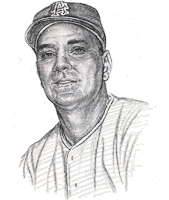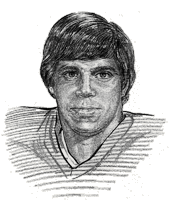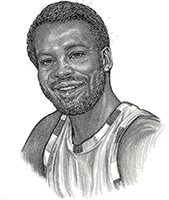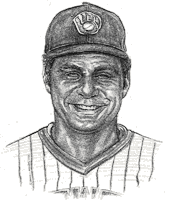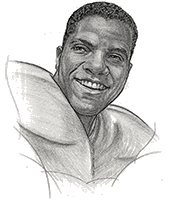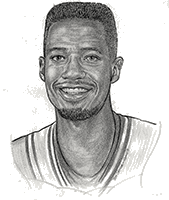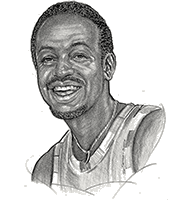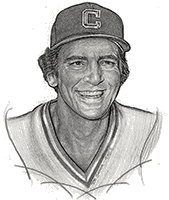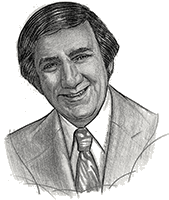One of Cleveland West High’s finest athletes, he led the Cowboys to the 1952 City High School Baseball Championship Game, only to lose the title clash in an 11-inning duel at Municipal Stadium. However, better days on the Stadium mound were ahead. The most memorable of those appearances came exactly a wearing a Los Angeles uniform as the staring pitcher for the American League in the 1963 Major League All-Star Game. That was his fourth and final appearance as an All-Star, all for the Angels with whom he set a team mark in 1962 with 10 consecutive victories and also compiled a string of 27 consecutive scoreless innings as a staring pitcher. His major league career, begun with the Chicago White Sox AL Championship team in 1959, ended with a shoulder injury prior to the 1964 campaign After several seasons as a minor league coach and manager he joined the Milwaukee Brewers as pitching coach in 1975, but retired in 1976 to take on his current position as president and chief operating officer of a Cleveland-based construction business.
He walked into his first Cleveland Browns camp in 1975 as a non-drafted free agent from Duke University where he had undergone five position shifts before the Blue Devils anointed him an offensive tackle in his junior year. It didn’t take the Browns nearly that long to decide the one-time North Carolina high school quarterback sensation was a guard, and by the eighth game of his rookie season he had settled in as a starter. That was the beginning of an 11-year run as a key player on some of the strongest offensive lines in Browns history. During those 11 seasons he missed only two games, was named Browns’ Man of the Year in 1981 and was selected to co-captain the 1985 team with future Hall of Famer Ozzie Newsom. He retired after the 1985 season to enter the insurance business, subsequently forming a partnership with Browns teammate (and now fellow Greater Cleveland Sports Hall of Fame member) Doug Dieken to create a highly successful insurance agency in suburban Westlake. He makes his home in Bay Village, where has managed to fit a volunteer high school coaching job into a busy schedule of community and charitable activities.
Five seasons in a Cleveland Cavaliers uniform were all the 6-11 Racine, WI native needed to establish himself as one of the finest players in team history. The verdict was first delivered in 1991 when fans voted him the starting center on the “Classic Cavs Team” covering the club’s first 20 years, and re-enforced a decade later when he was named to the 12-man All-Time Cavs Team. An All-American for a 25-4 Marquette University quintet in 1971-72, when he averaged 20.5 points and 11.9 rebounds per game, and a member of the 1971 U.S. Pan-American Games team, he turned pro in 1973. After two seasons in the American Basketball Association (ABA), he joined the Cavs for the 1974-75 season. His finest year came in 75-76—the memorable “Miracle of Richfield Year”—when he averaged a career high 15.8 ppg, but he scored in double figures in each of his five Cavs seasons, while his 3,790 rebounds rank third on the team’s all-time leaders list. He ended his playing career with two seasons in Los Angeles, where he was a member of the Lakers’ 1979-80 championship squad and two years with European teams, then returned to Cleveland and worked for 11 years as a Cavaliers television analyst. He now resides in Orange Village and is marketing director for a construction company.
Cleveland-born and raised, he parlayed a solid athletic career at Warrensville Heights High and a series of strong summer performances for highly respected sandlot teams into a baseball scholarship at perennial baseball power Arizona State. When he was named the MVP of the 1965 College World Series, won by ASU, the door was opened to one of the finest major league careers ever enjoyed by a Greater Cleveland native. Drafted by the Kansas City Athletics prior to their move to Oakland, he enjoyed 11 seasons as the A’s third basemen, playing a major role in the team’s three consecutive World Championships in 1972-73-74, playing on four American League All-Star teams and compiling career statistics which still rank him in the A’s top three in six categories. He went on to play five seasons with the Milwaukee Brewers, retiring at the end of the team’s pennant-winning season in 1981. Subsequently he became a special assistant to the Brewers general manager, was promoted to general manager in October, 1991, and held down that position for eight seasons. He remains active in Milwaukee community affairs and makes his home in Mequon, WI.
Deceased 2023
Playing for the awesome Cleveland Browns teams of 1947-1953 which produced seven players and a head coach now enshrined in the NFL Hall of Fame, he was one of the very best. An All-American tackle at Ohio State, he became the first African-American player signed by an All-American Football Conference team when Paul Brown recruited him for his new Browns team in 1946. Despite weighing barely 215 pounds he became an immediate starter both on the offensive and defensive line. But it was his lightning quickness and devastating tackling as a middle guard that elevated him above the pack. And it was those skills which he combined to create his signature play, one which deserved a permanent niche on the positive-side list of sports memories forever emblazoned in the minds of Cleveland’s long-suffering sports fans, opposite “The drive,” “The Fumble,” and “the Shot.” “The Tackle” took place on the afternoon of December 17, 1950 in the final quarter of the NFL American Conference championship game between the Browns and the New York Giants. With Cleveland clinging to a fourth quarter 3-0 lead, the Giants Choo-Choo Roberts broke into the open from the Browns’ 36 and seemed headed for a decisive touchdown when suddenly Willis flashed into the picture. Gaining ground with every step, he caught Roberts from behind at the four, paving the way for an 8-3 victory and a conference title which enabled the Browns to move on to capture the NFL championship in their first season in the league. It may have been the best of many incredible feats that were to earn him selections to three All-AAFC and four All-NFL teams, to play in three NFL Pro Bowls, to help his teams to four AAFC and one NFL title and propel him into the NFL Hall of Fame in 1977.
Deceased 2007
Joe left the comparative tranquility of rural Illinois in 1970 to accept an offer to come to Cleveland and become the radio play-by-play voice of the newly formed Cleveland Cavaliers. It turned out to be one of the best deals the Cavs ever made. Certainly none of their transactions have had a longer lasting impact on the community. Beginning his broadcasting career in 1956 as an undergraduate at Monmouth College by airing the games of his beloved future alma mater, he happily stuck with it for 14 seasons before the Cavs uncovered him. Now, when the Cavs’ 2005-06 season opens he will be starting his 51st year in broadcasting, his 34th season with the Cavs and his 36th year of doing NBA basketball (he left to broadcast the New Jersey Nets games in 1981-82 and those of the Chicago Bulls in 1982-83). Even in his two seasons away from the Cavs, his familiar baritone continued to boom across the Cleveland airwaves calling the games of the Cleveland Indians on radio and/or TV, assignments be handled from the 1972 to the 1988 seasons. In 1988, Cavaliers management, deciding perhaps the man might have some promise, tightened their grip on him by naming him their broadcast vice president. Now the unchallenged dean of Cleveland sportscasters, he has, entering the 2005-06 season, broadcast 2,747 Cavaliers games as well as all 188 games of the organization’s currently defunct women’s counterpart, the Cleveland Rockers, plus well over 2000 Indians contests. In addition, he has been the TV voice of Mt. Union College football for 17 years. During these years he has been chosen the Ohio Sportscaster of the Year eight times, and will be entering his sixth Hall of Fame with his induction into the Greater Cleveland Sports Hall of Fame. But who’s counting?
Warrensville Heights already boasted an enviable record as a small school which produced outstanding athletes when one of its future students began his adolescent growth spurt in the mid-70s. By the time he reached high school age, he was nearly seven feet tall, and while he was a bit on the spindly side, it was evident that WHS was on the brink of welcoming its next quality sports star in the person of basketball prospect Brad Sellers. Hope became reality, and by the time he reached his senior season, major college scouts were beating a steady path to the doors of the Tigers gym. Wisconsin won the recruiting battle and Sellers enjoyed two good seasons in Madison, averaging 15.3 points and nine rebounds over 55 games in 1981-82 and 1982-83. His 838 points made him just the fourth UW player to top 700 by the end of his sophomore season. But, at the end of that second season, he elected to transfer to Ohio State, where he stepped it up a notch, averaging 17.8 points and a prodigious 10.8 rebounds over two years. His 416-rebound total in 1985-86 still ranks as the fourth best single season total in OSU history. Even more impressive, his 187 blocked shots rank as the Bucks’ third best CAREER total. The Chicago Bulls made him the 9th pick in Round One of the 1986 NBA draft and he went on to play the first three of his six NBA seasons with Chicago, then split three ensuing campaigns among Seattle, Minnesota and Detroit. Although his best season was the 1987-88 campaign with the Bulls when he started 76 games averaging 9.4 ppg, his most memorable moment may have come in the 1987 playoffs when he made the last second pass to Michael Jordan that Jordan converted into “The Shot” which eliminated Cleveland from the playoffs. Still living in Warrensville Heights, he is now the city’s community liaison director.
Honors went hand-in-large-hand with the consistently solid basketball play of one Michael “Campy” Russell during a spectacular college and professional career. The Pontiac (MI) Central High product played just two varsity seasons with the University of Michigan, averaging 18.4 points as a sophomore, then 23.7 points and 11.1 rebounds as a junior in 1973-74. His second-year totals were enough to enable him to lead the Big Ten in scoring, finish second in rebounding, earn unanimous acclaim as the Big Ten Player of the Year and All-American status, and sufficiently impress the Cleveland Cavaliers to take him with the 8th overall pick in the 1974 NBA draft. He more than lived up to his college reputation during a nine-year pro career which ended in 1984. Seven of those seasons were with the Cavs, reaching a zenith in 1978-79 with a career high scoring average of 21.9 ppg, a single game career high of 41 against Phoenix and a place on the NBA All-Star team. He averaged 15.0 ppg for the Cavs’ revered “Miracle of Richfield” team of 1975-76, which made the playoffs for the first time and advanced to the second round. He finished his playing days, which included two seasons (1980-82) with the New York Knicks, with a cumulative NBA scoring average of 15.8 ppg and a playoff scoring average of 16.6 ppg. From 1975-76 through the 1981-82 season, he averaged double figures in scoring every year. In 1999 he was voted to the Cavs’ all-time team and into the University of Michigan Hall of Honor in 2002. He lived in Michigan from shortly after retirement as an active player until 2002 when he accepted an offer to return to the Cavs as an Outer Market Event Specialist. A proud father of five, Campy currently makes his home in Shaker Heights.
Joe Nossek spent 43 years in professional baseball, 37 of them in a major league uniform. No native Clevelander had ever matched those numbers when he hung up his Chicago White Sox uniform for the final time in the spring of 2004 to retire with his wife, Jean, to their home in Amherst. His lengthy list of baseball honors began accumulating early. He earned first team All-Ohio laurels as a senior at Euclid High in 1958, after which he was signed from Ohio University as an amateur free agent by the Minnesota Twins in 1961 after winning first team All-American and All-Mid-American Conference recognition. He joined the Twins as an outfielder in 1964, beginning a six-year career which included stops at Kansas City/Oakland and St. Louis, including the realization of the dream of every player when he appeared in six games of the 1965 World Series with the Twins. When his playing days ended, he spent two years as a minor league coach and manager, then joined the Milwaukee Brewers as their third base coach in 1972, launching the long final phase of his career in which he established himself as one of the most astute coaches in the game and perhaps baseball’s finest sign stealer. His tour on the coaching sidelines included five years back home as the Indians’ third base coach and culminated with a 20-year stint from 1983 through 2003 in Chicago, the last 13 as the White Sox bench coach.
On a quiet news day in 1968, unsuspecting Greater Clevelanders were mildly surprised to learn that a little-known local attorney had purchased the Cleveland Arena and its prime tenant, the Cleveland Barons of the American Hockey League. Little did they know they were reading the opening chapter of a local sports saga which in the next decade would see the construction of the largest sports empire in the city’s history, with surprises galore to come. The ink had barely dried on the Arena purchase papers when Nick Mileti set out to lure an NBA expansion team to his new building. In 1970 he was rewarded with a team he named the Cleveland Cavaliers and dressed in the Wine and Gold colors of his alma mater, John Adams High. Next, he turned his eyes to the Cleveland Indians, who were openly seeking greener fields. Teaming with a group of civic activists, he purchased the team on March 22, 1972 for $9 million. A month later, learning the Calgary Broncos of the newly-formed major league-conscious World Hockey Association would be shifted because of financial woes, he bought the franchise, shuffling the minor league Barons off to California. Now, with two indoor sport teams in his bulging major league stable, he turned his attention to replacing the aging Arena with a state-of-the-art big league home. Unable to work out an arrangement for a site in the City of Cleveland, he pulled off his climactic sports surprise by building the opulent 22,000-seat Coliseum midway between Cleveland and Akron on a site in Richfield literally surrounded by cornfields. He opened the building with a gala Frank Sinatra concert in 1974. The empire would slowly dissolve after that, but when he left Cleveland in 1979 for Beverly Hills to produce and finance plays and motion pictures, he left behind him Indians and Cavaliers teams whose presence would serve as the impetus for the construction of a new downtown sports complex forever altering the heart of downtown Cleveland.
Deceased 2024
2001 Crocker Rd., Ste. 510, Westlake, OH 44145
Phone: 216-241-1919

